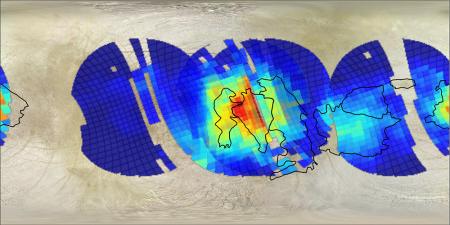The Most Interesting Place On Europa
Landing in this intriguing region may reveal whether the icy moon could support life

A vast ocean lies inside the icy shell of Jupiter’s moon Europa. Whether that ocean might be home to simple alien beings is one of the great mysteries of astrobiology. It’s a mystery that probably won’t be easy to solve, since the ocean is buried under miles of ice. But a new paper suggests there may be a different way to taste Europa’s ocean–and it doesn’t involve sampling the elusive plumes of water that may sometimes spew from the moon’s south pole.
Recently accepted by the Astronomical Journal, the study maps the infrared wavelengths emitted across Europa. Different materials in the crust give off different wavelengths, providing insight into what Europa’s made of. One of the regions unveiled by the new map could make a perfect landing site for future spacecraft, according to astronomer Mike Brown, a co-author on the paper.
Although there are currently no plans in the works to put a lander on Europa, a mission informally named ‘Europa Clipper’ could fly by the small moon after launching in the 2020s, and scientists are pushing to get a lander onboard. Brown says he hopes that by identifying a potential landing site, the research will help to spur the conversation forward.

Europa
Mapping the composition of Europa’s surface turned up three distinct areas. Two of the sites were known before now.
“One is just generic water ice, like you would expect,” says Brown. “The other is what you would expect if you have water ice that’s bombarded by radiation from Io and Jupiter. But we found a third component that we didn’t know was there before.”
Intriguingly, the component (scientists aren’t sure what it is) is located in an area of ‘chaos terrain’. In these areas, the ice looks like it’s been splintered and broken, then messily refrozen. Scientists have been interested in landing in one of these chaotic regions for years now, since they seem to be “young” areas of recent activity.

Closeup of a chaos region on Europa
It’s not clear how the chaos terrain formed, but some scientists–including Brown and his co-authors–think these may be regions where Europa’s inner ocean bubbled through to the surface and froze. If that’s the case, then the mystery component may be a residue from the subsurface ocean, providing hints as to what’s inside the icy moon.
Other researchers think the chaos terrains might have formed from collapsing lakes or large impacts–in which case, the surface won’t necessarily reflect what’s inside Europa’s ocean.
The mystery component’s identity remains, well, mysterious. But the team suspects it’s some kind of salt that washed up from the ocean and got left behind after the water evaporated or froze. They hope to learn more through laboratory experiments and by observing Europa in different wavelengths.
“It’s the best spot to go look.”
It’s almost certainly impossible for life to exist on Europa’s surface. It’s quite cold there, and the surface is bombarded with radiation from Jupiter and its moon Io. So a lander at this site almost definitely wouldn’t detect life. Still, it’s possible that the salty remains would provide clues as to what the ocean is made of, and whether it might be capable of supporting life.
Drilling through miles of ice on another world requires technology that we do not yet have. Apart from circumventing that need, the potential landing site has another advantage: it’s partially shielded from the radiation that can break apart biologically interesting molecules, as well as damage spacecraft.
“It’s the best spot to go look,” says Brown. “I think it would be a shame to go all the way to Europa, flying by and mapping it, and not putting a lander on it. We actually have all of the technology to land on Europa and answer these questions right now.”